Matches played in the group stage are different from the round of 16 in any international competition.
Theoretically, opponents become tougher as you progress towards the later stages of a tournament and they also have a better idea of how you have played up to that point.
After three matches, it is possible to analyze how a team plays with and without the ball with a recent sample, rather than one taken during international friendlies in March and June.
If we take Germany as an example, their opponents now know that when in possession of the ball, Toni Kroos will move to the left side of the defence to form a 3-1 with Robert Andrich in front of him.
From that deep position, Kroos leads Germany’s attacks as they try to find the three narrow No.10s between the lines. “Playing with Toni, I have the freedom to stay more forward and wait because you know the ball is going to come at some point,” Ilkay Gundogan said recently. Athleticism.
“He reads the game, gives us balance with and without the ball, and he gives other players like me more freedom to put themselves in dangerous positions.”
Therefore, any team that wants to limit the German threat on the ball and not fall victim to the complex combinations of Gundogan, Jamal Musiala, Kai Havertz and Florian Wirtz must stop the supply at its source.
The round of 16 brought a new contender, with Denmark looking to do so by first pressing Germany’s 3-1 preparation and sorting out the rest of the problems later.
Out of their 5-4-1 shape, Denmark focused on the pressing of Antonio Rudiger, Nico Schlotterbeck and Kroos using Christian Eriksen, Rasmus Hojlund and Andreas Skov Olsen, with Thomas Delaney and Pierre-Emile Hojbjerg in zonal roles behind them.
Eriksen had a complex role as he had to position himself and support Denmark’s left back and central defender, but Skov Olsen’s main task without the ball was to stifle Kroos and not give him time to play with the ball.
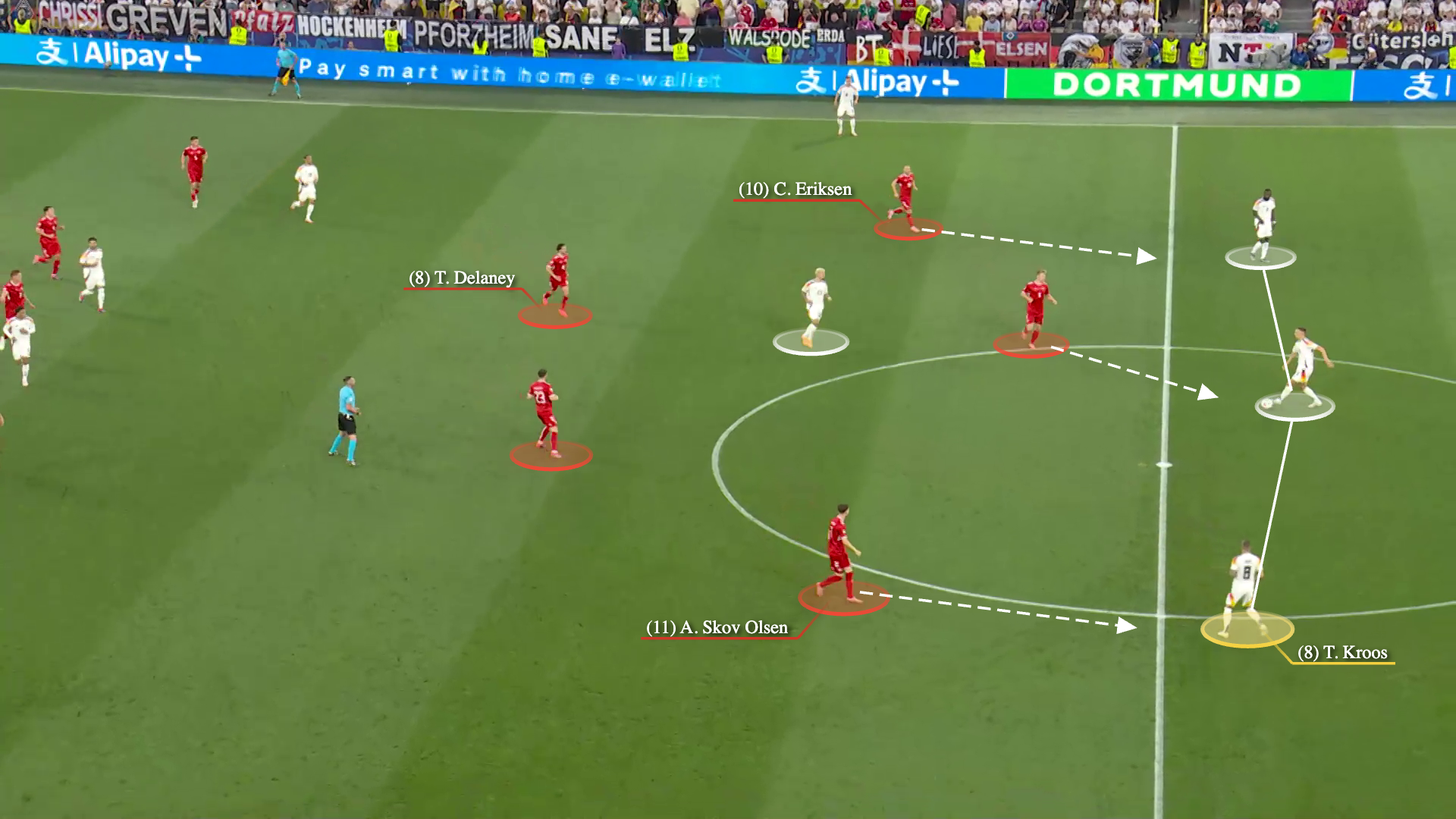
The logical question was how Denmark could use five players to press four German players without getting into trouble, as that numerical advantage offered Julian Nagelsmann’s team a six-on-five scenario behind Delaney and Hojbjerg.
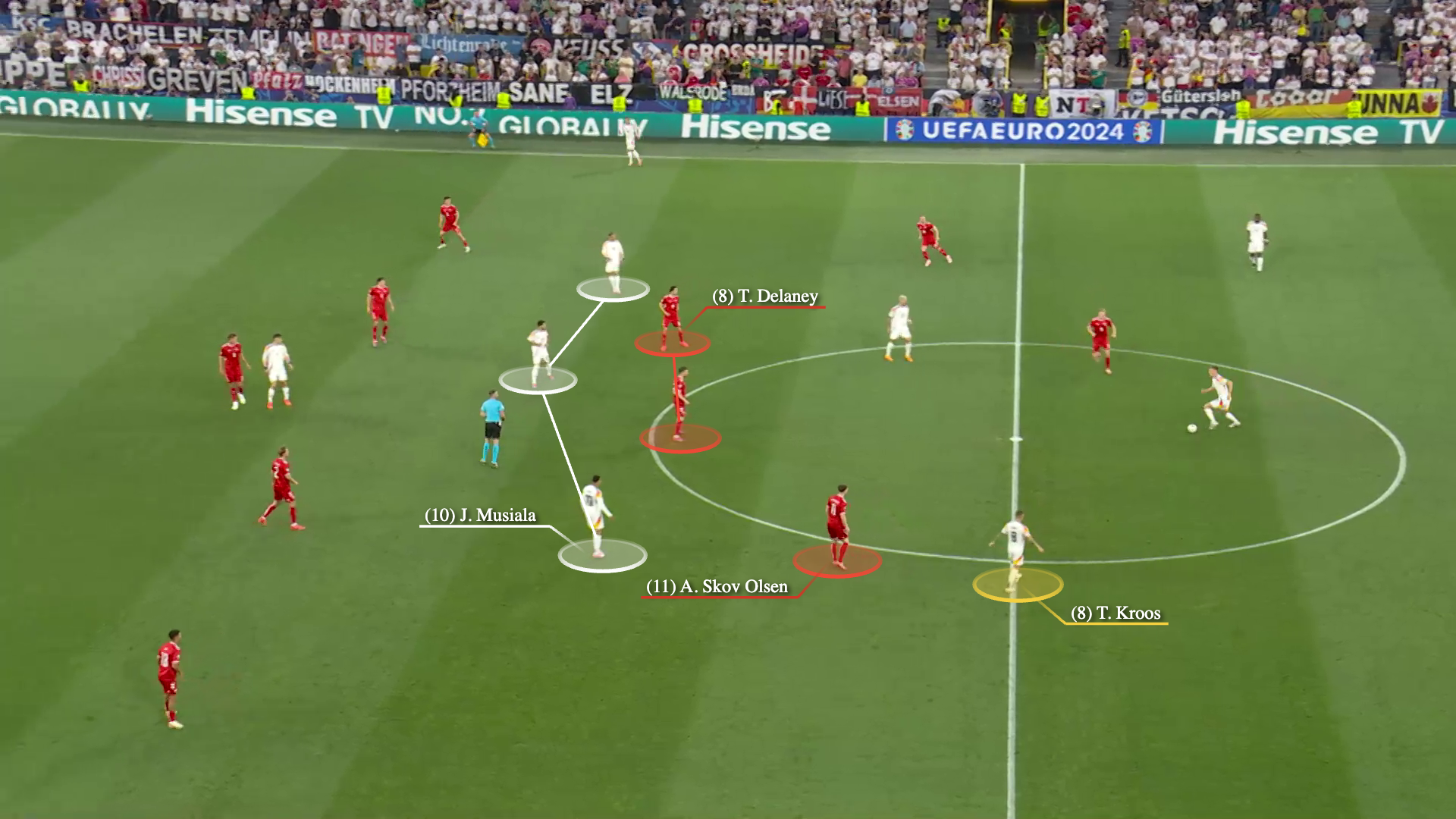
The first part of the answer was that the Danish midfield duo dropped out to help their central defenders follow Leroy Sane, Gundogan and Musiala.
Here, Skov Olsen presses Kroos and Delaney collects the deflected pass, but even though it goes around the attacker, Hojbjerg heads towards Musiala.
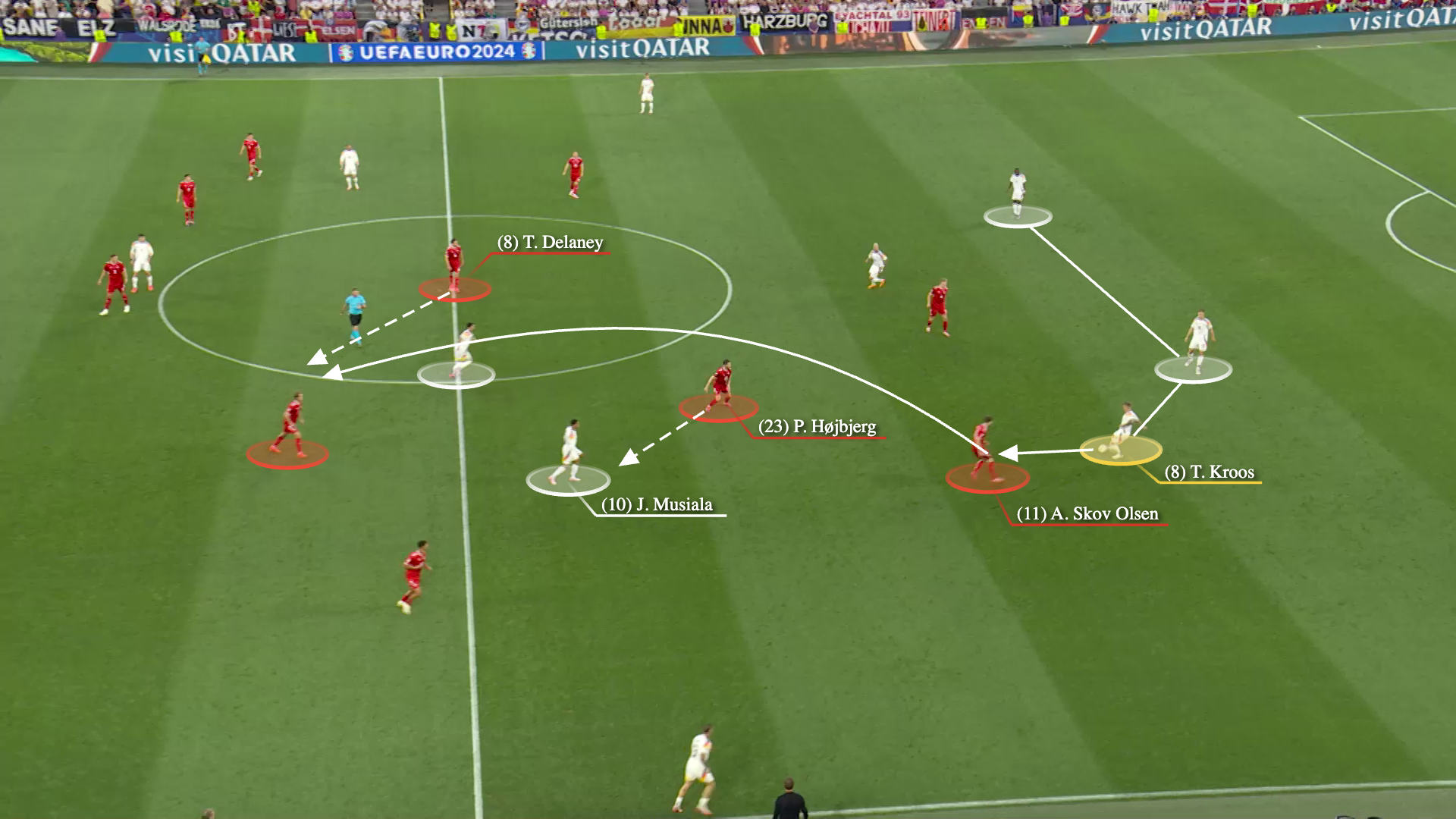
The other was that the five Danish defenders changed markers effectively to defend against the three German number 10s.
In this example, Schlotterbeck finds an angle to pass towards Gundogan, but Jannik Vestergaard immediately jumps towards the German captain and Joachim Andersen moves inside to collect Havertz.
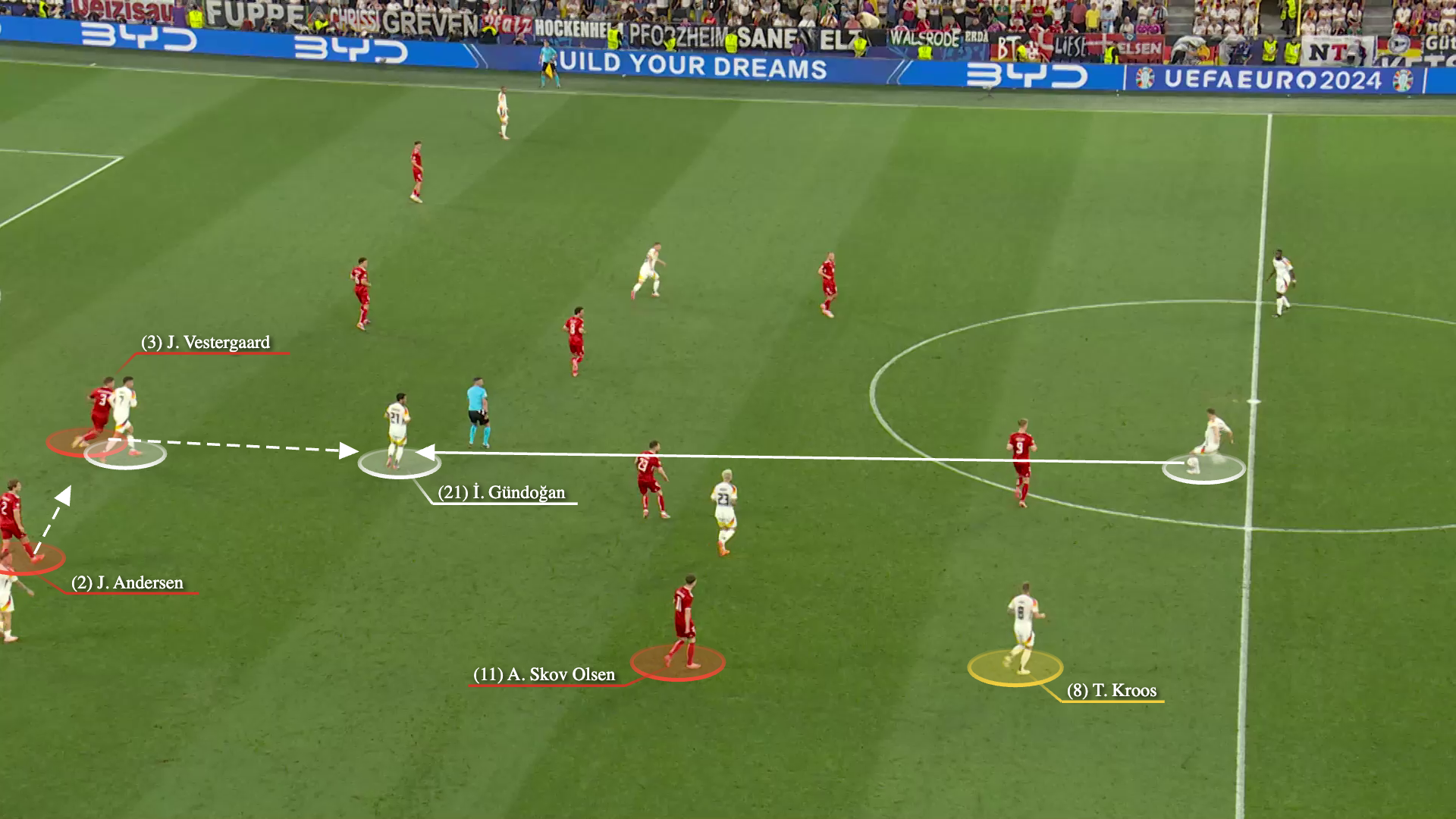
Gundogan then tries to return the ball to the Arsenal striker, but Andersen intercepts it and launches the counterattack, finding Skov Olsen.
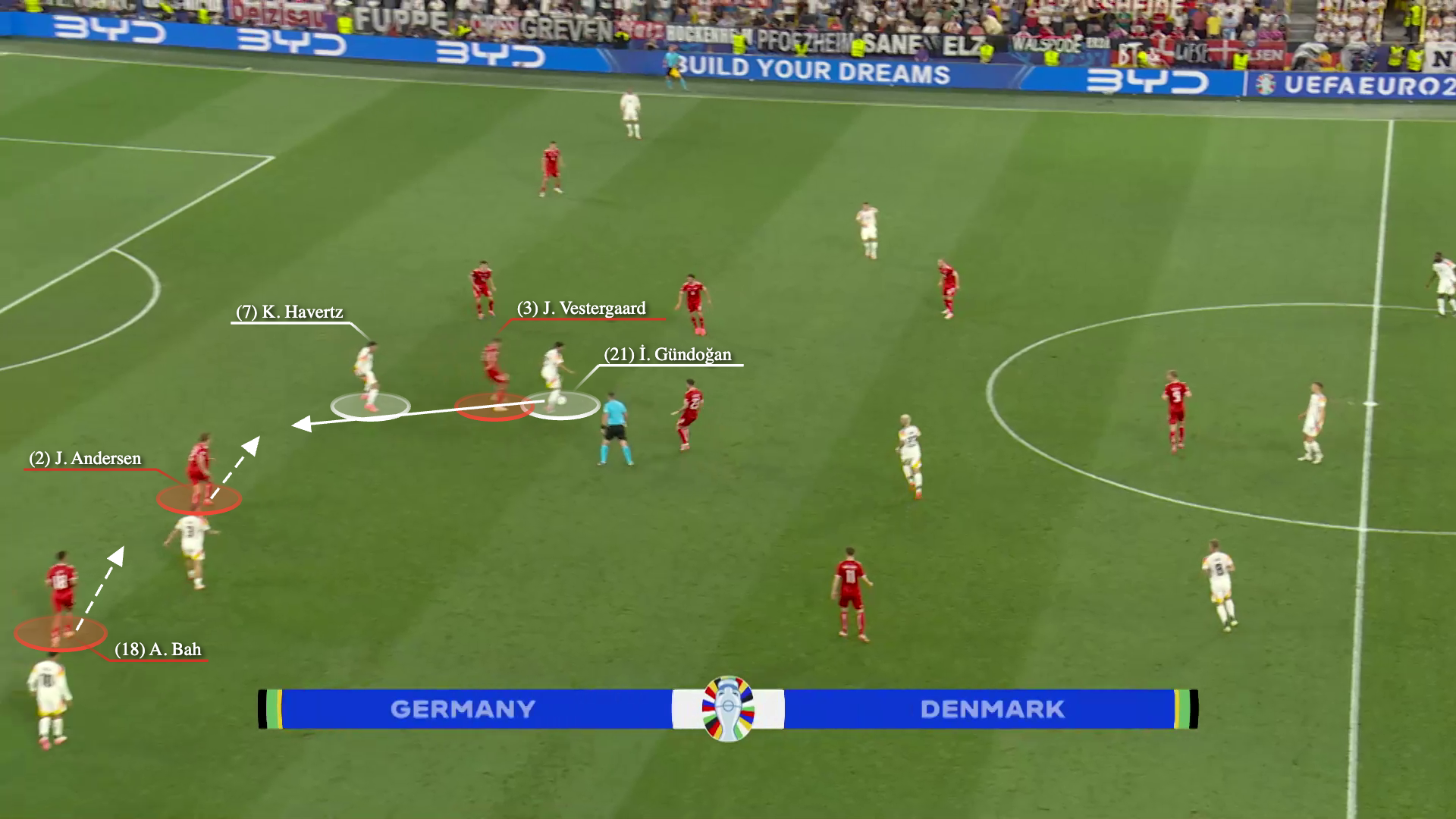
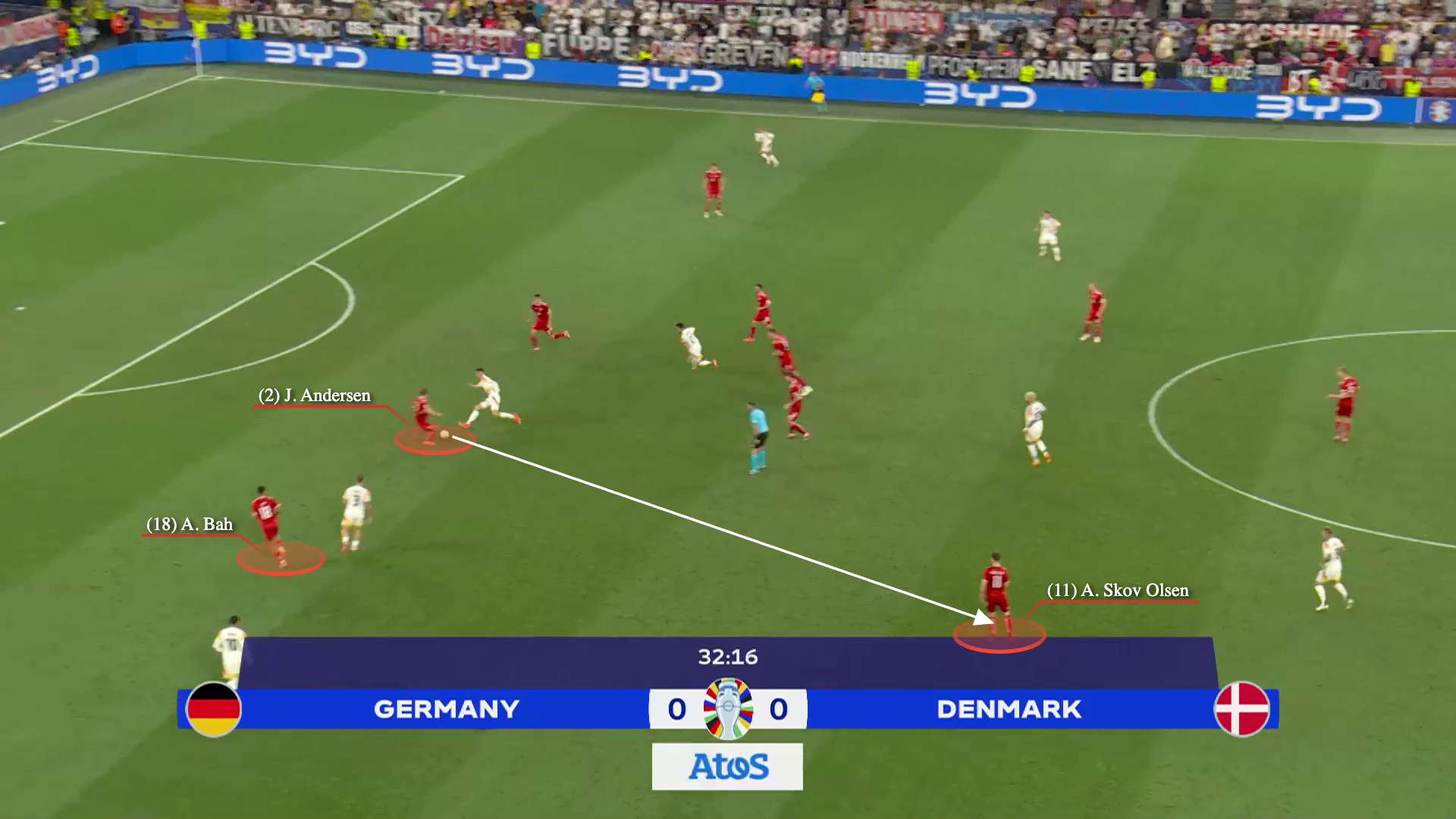
Germany’s impressive start to the match was tempered by Denmark’s organization without the ball, which also created transitional situations for Kasper Hjulmand’s team. Pressure from Skov Olsen forced Kroos to make safer passes instead of crossing the line and, on a few occasions, make mistakes.
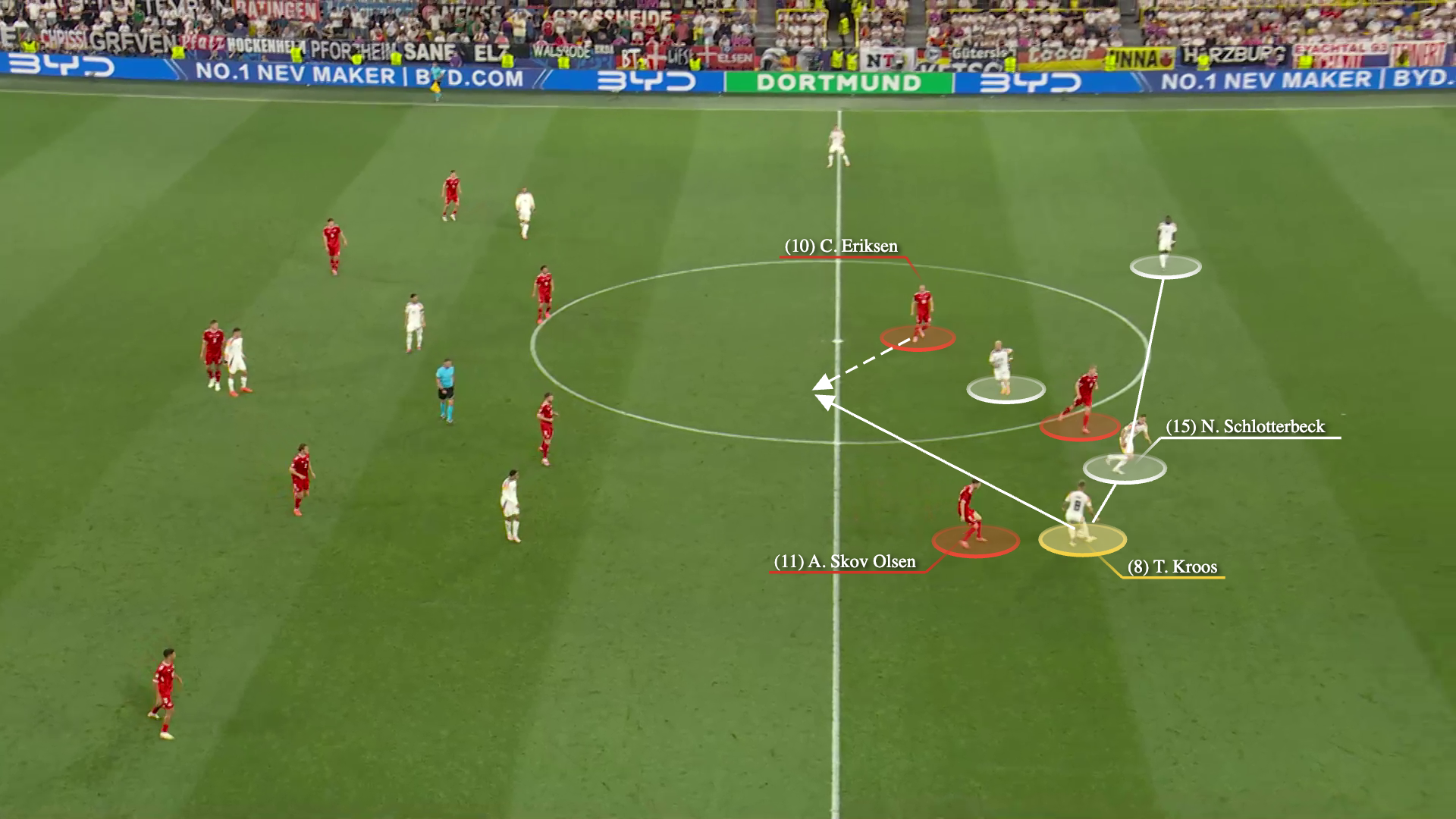
Denmark’s best chance of the first half came from winning the ball back and striking on the counter. Here, Eriksen is deeper to support the left side of the Danish defence, Hojbjerg picks up Gundogan, Skov Olsen puts pressure on Schlotterbeck and Hojlund is able to limit Kroos’ time on the ball. This forces the German midfielder to play the quickest available pass to Musiala and Andersen jumps to press him.
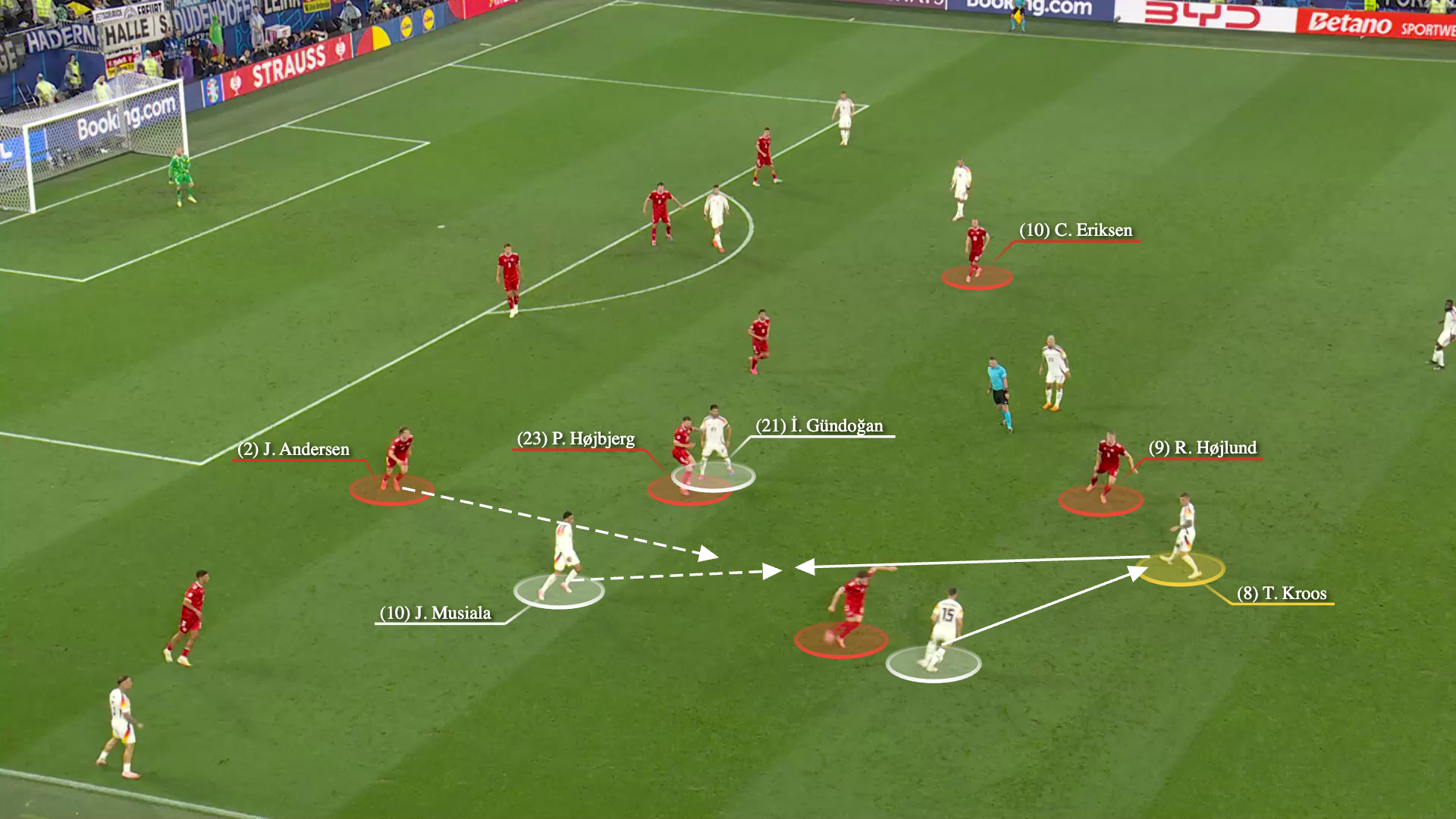
Musiala tries to find Andrich, but Delaney intercepts the pass to start the counter-attack and it ends with Manuel Neuer saving a one-on-one situation against Hojlund.
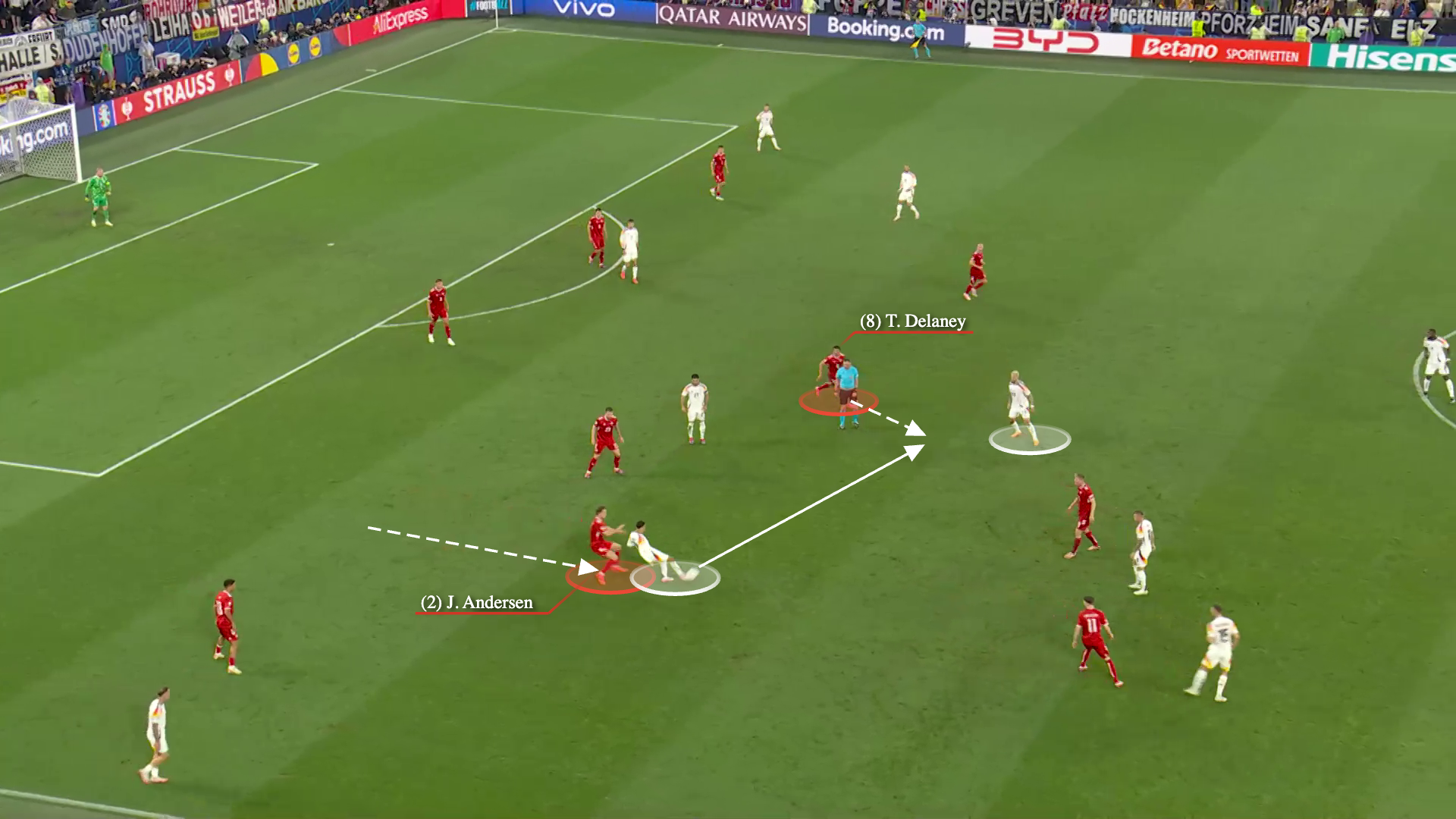
Denmark’s approach with the ball limited Germany’s attacking threat in open play, but Nagelsmann’s side showed they had several solutions with the ball.
Due to Eriksen’s complex role out of possession, Rudiger had more time on the ball than Schlotterbeck and Kroos and the Real Madrid defender attempted to find Havertz’s run behind the defense on several occasions.
Similar to the move made in the 2-0 win over Hungary, Havertz attacked the space behind the centre-back as the latter stepped up to mark one of Germany’s number 10s.
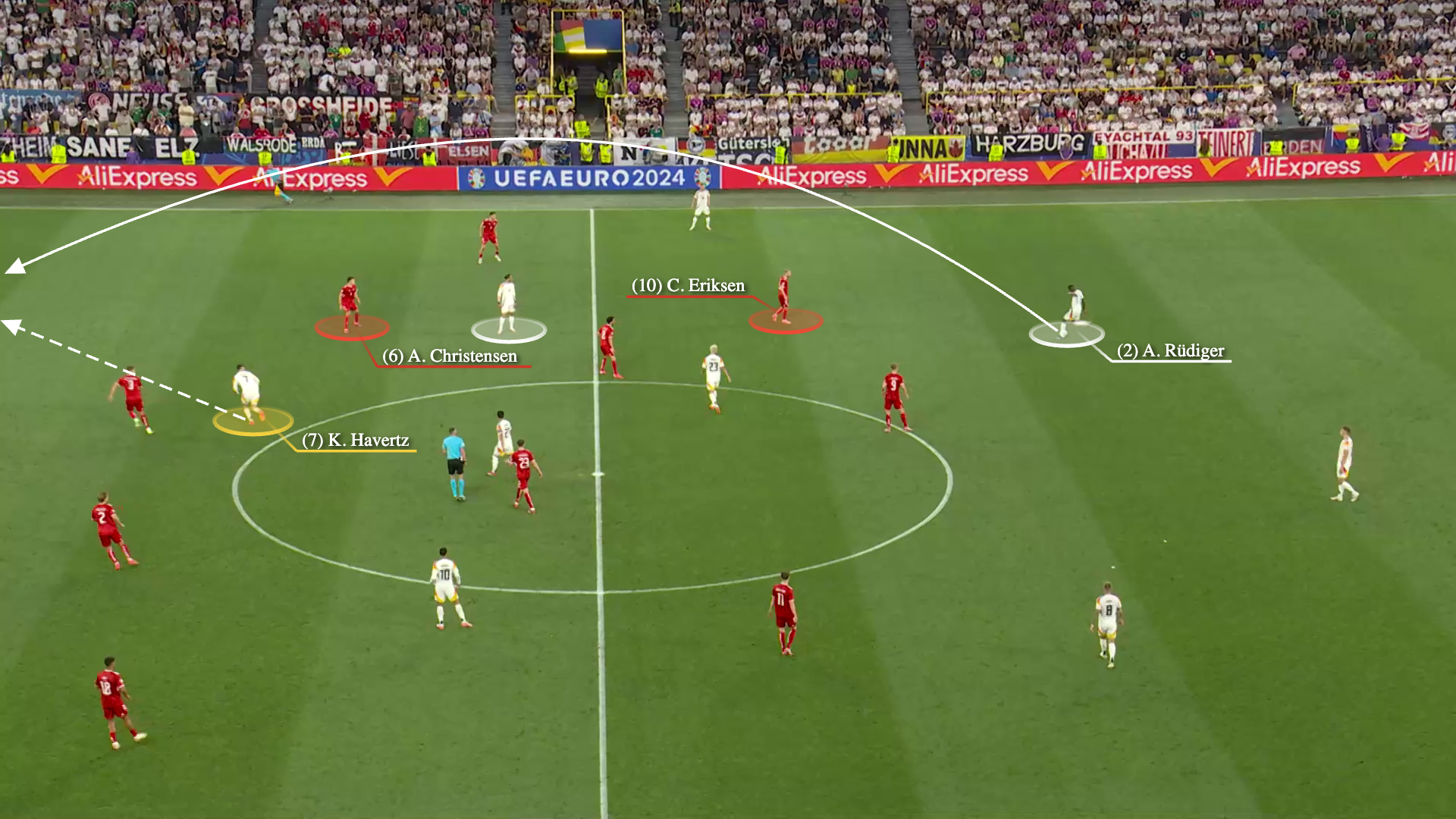
In this example, Eriksen is deeper than Skov Olsen, allowing Rudiger more time on the ball compared to Kroos.
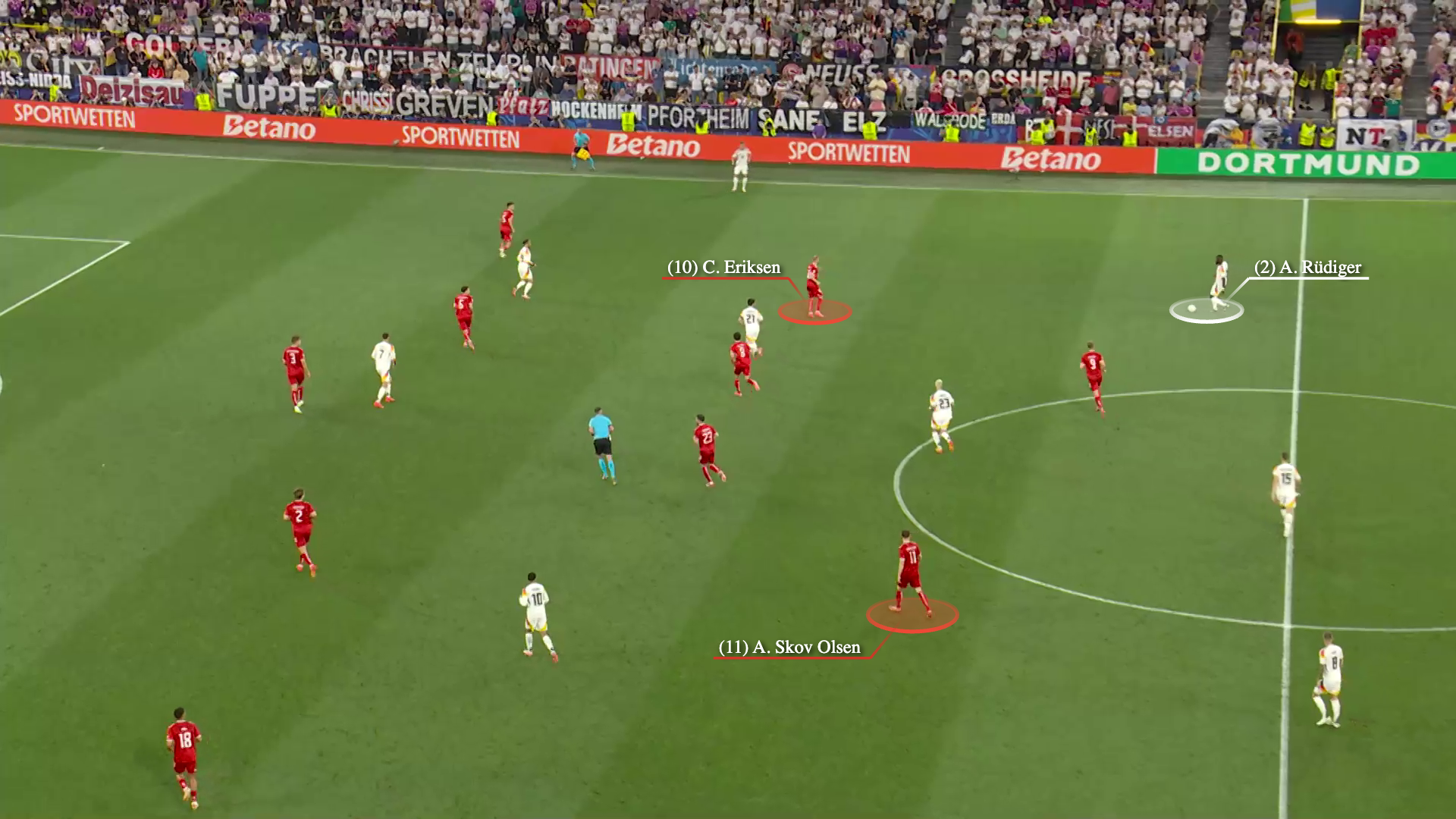
While the central defender looks for runners, Havertz attacks the space behind Andreas Christensen, who must watch Sane. Rudiger’s pass finds Havertz, but Vestergaard is in the right position to defend this attack.
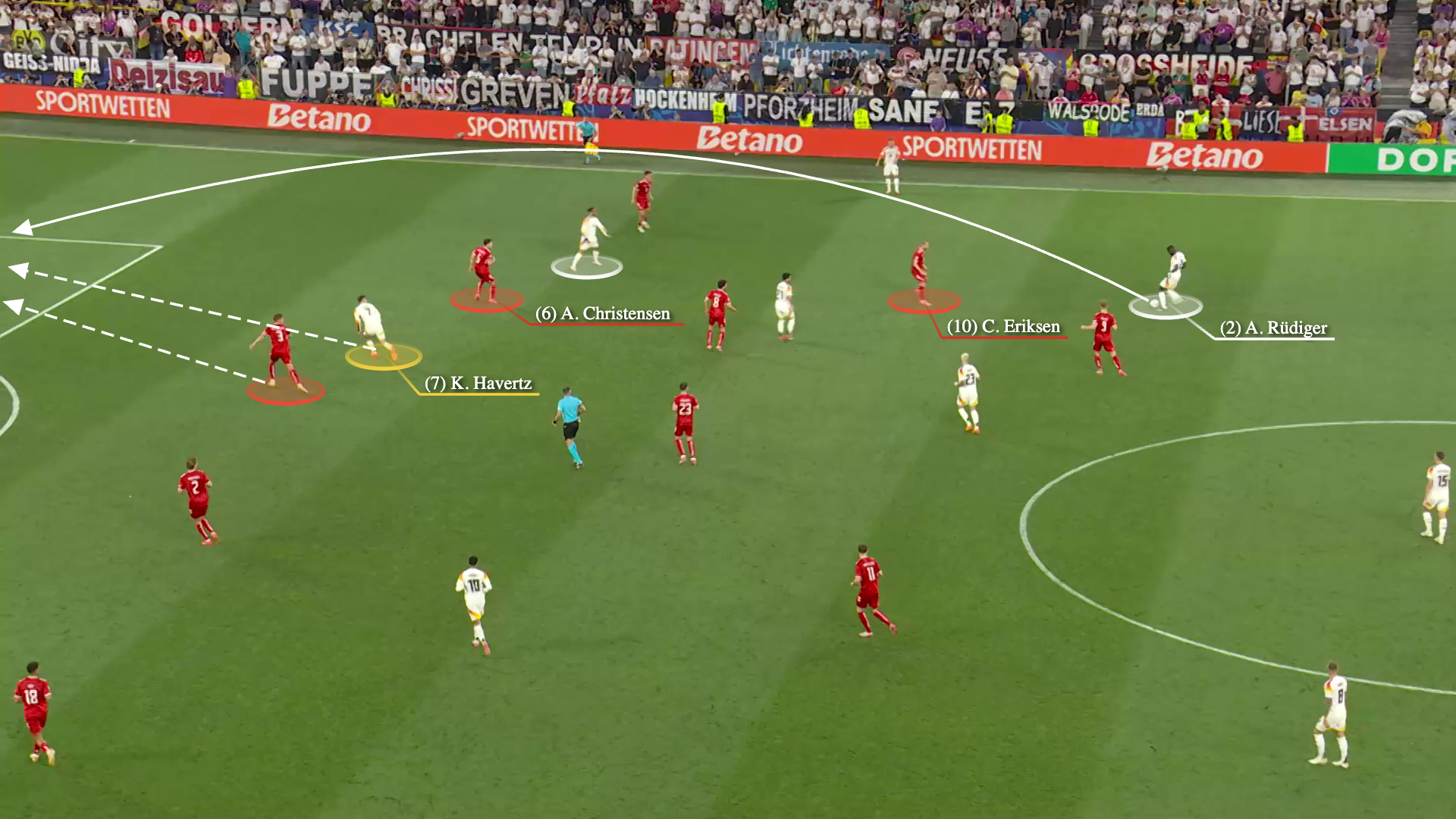
In another example, Andersen moves to follow Musiala’s positioning between the lines and Havertz moves intelligently to the vacant space in the Danish defence.
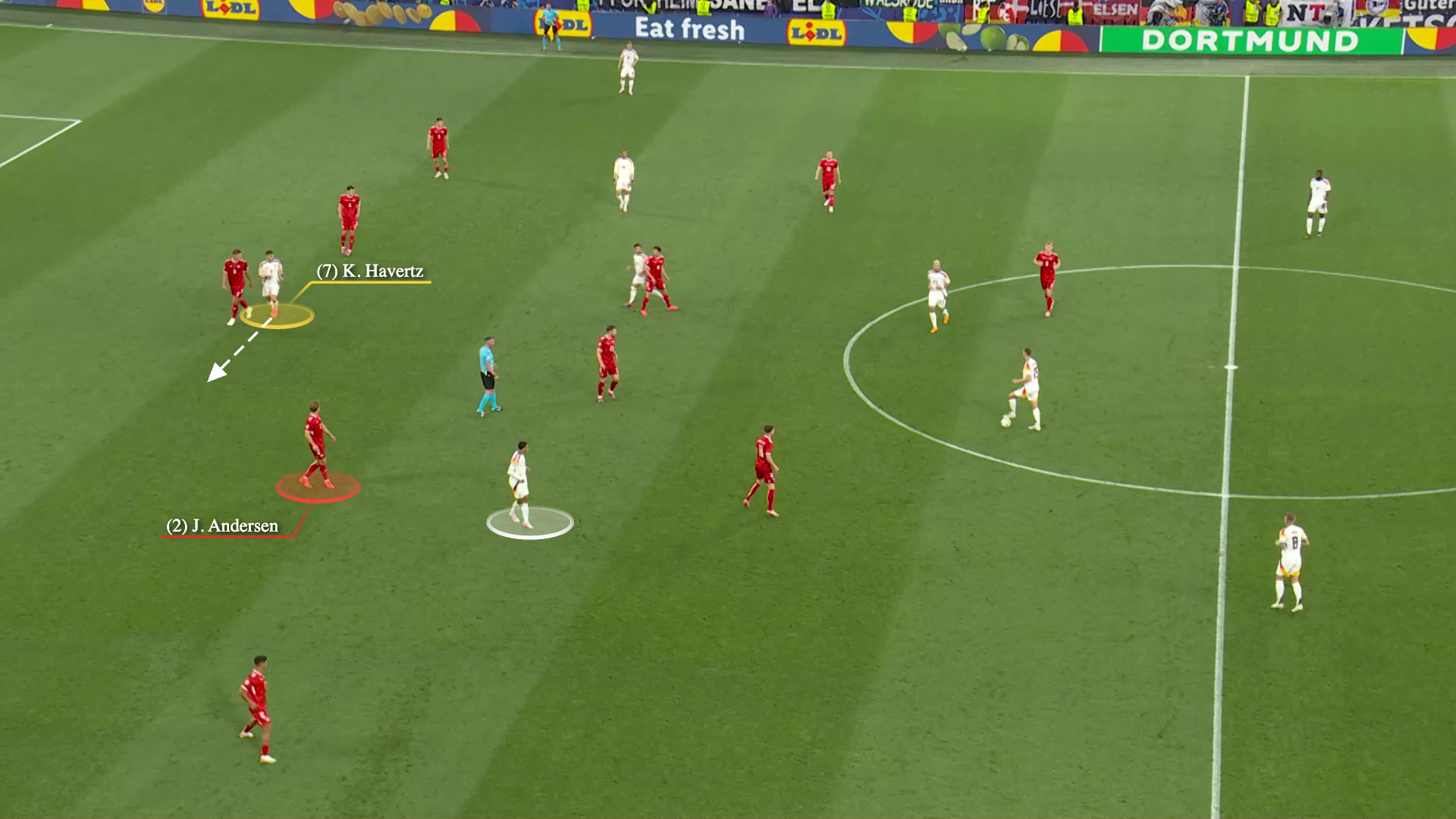
When Andrich passes the ball to Rudiger, Havertz is in a position to attack the space behind Andersen…
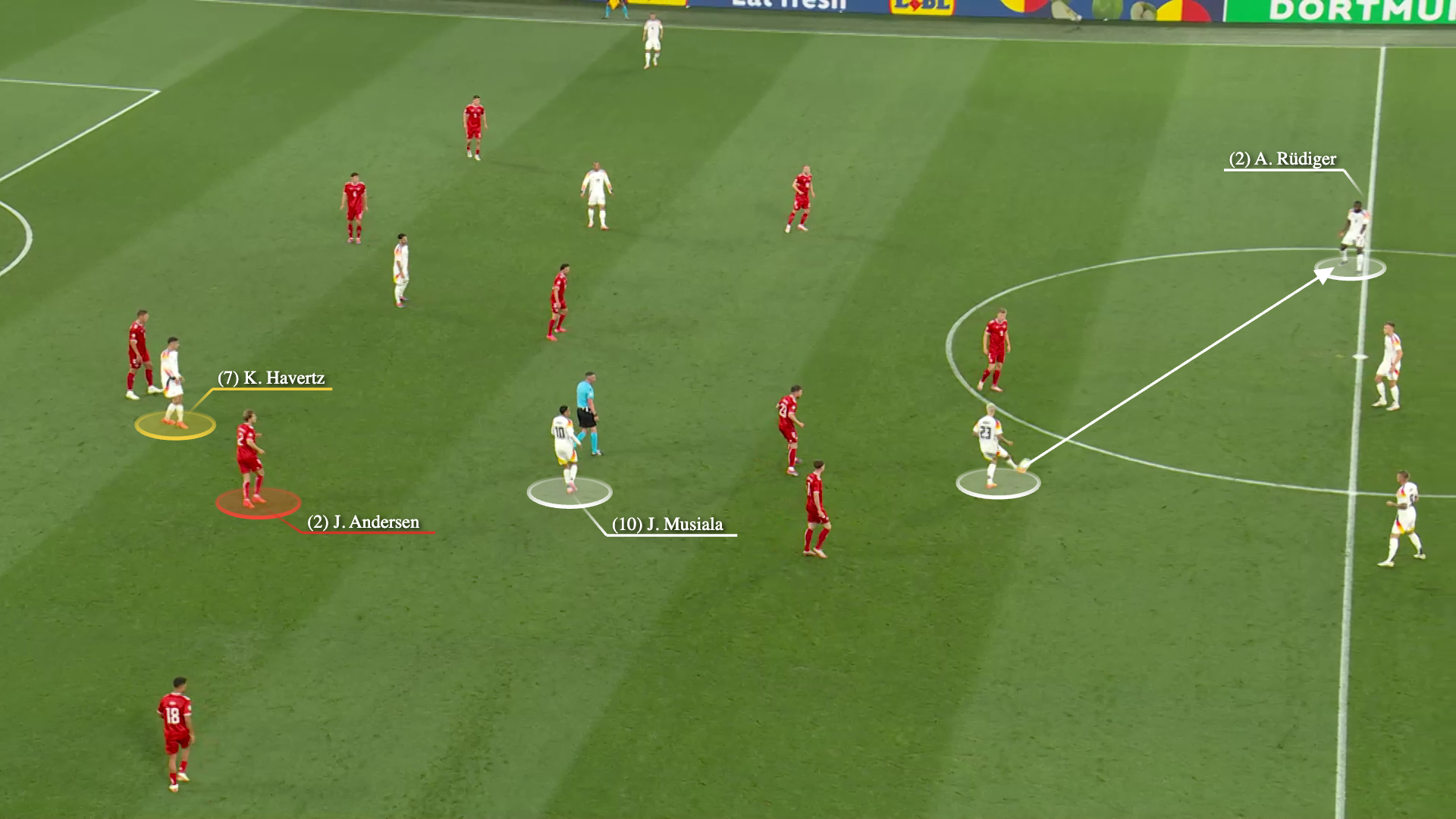
…and he runs away into that area while he is in Vestergaard’s blind spot. Rudiger finds him…
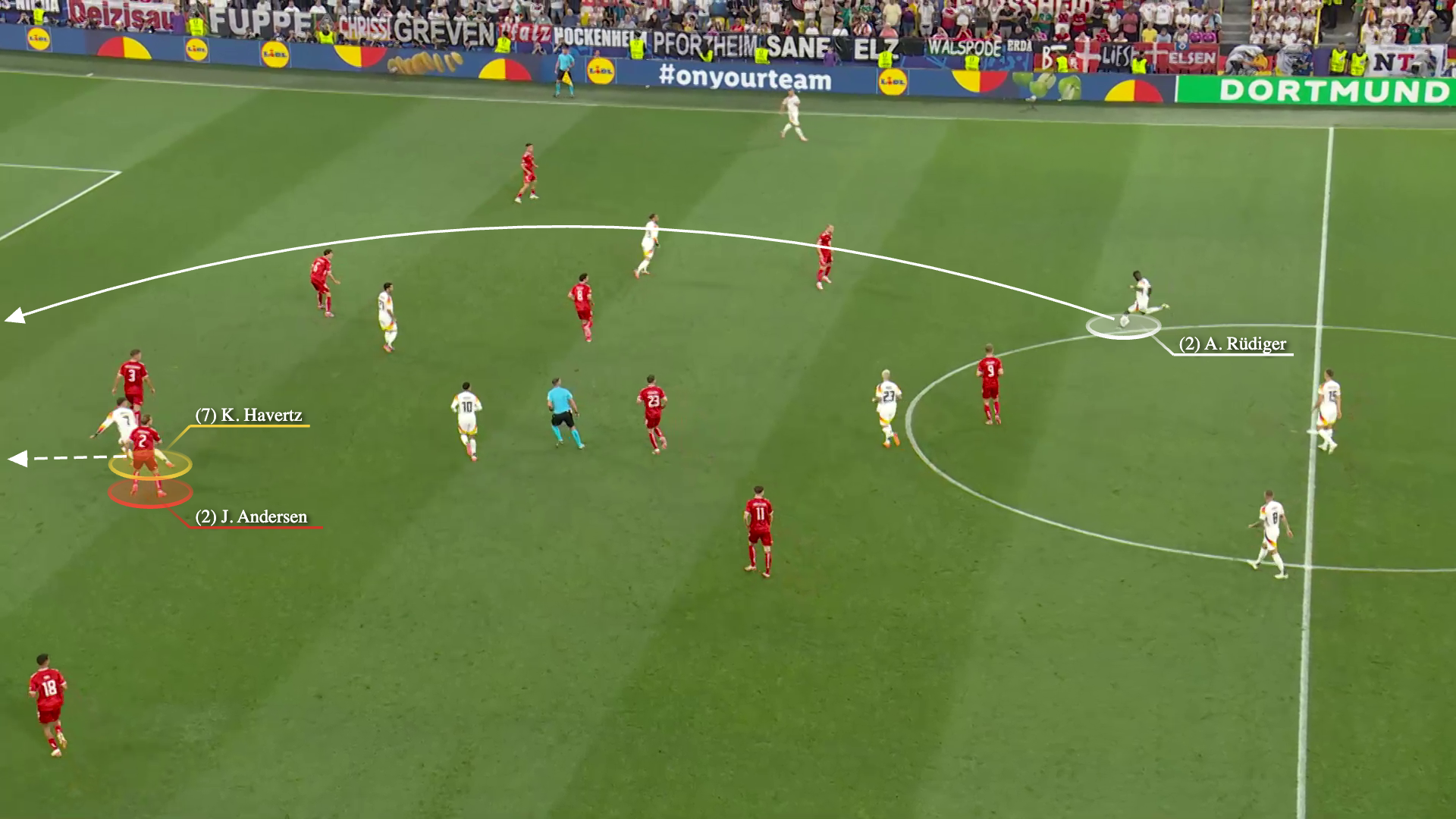
…but Havertz’s shot is stopped by Kasper Schmeichel.
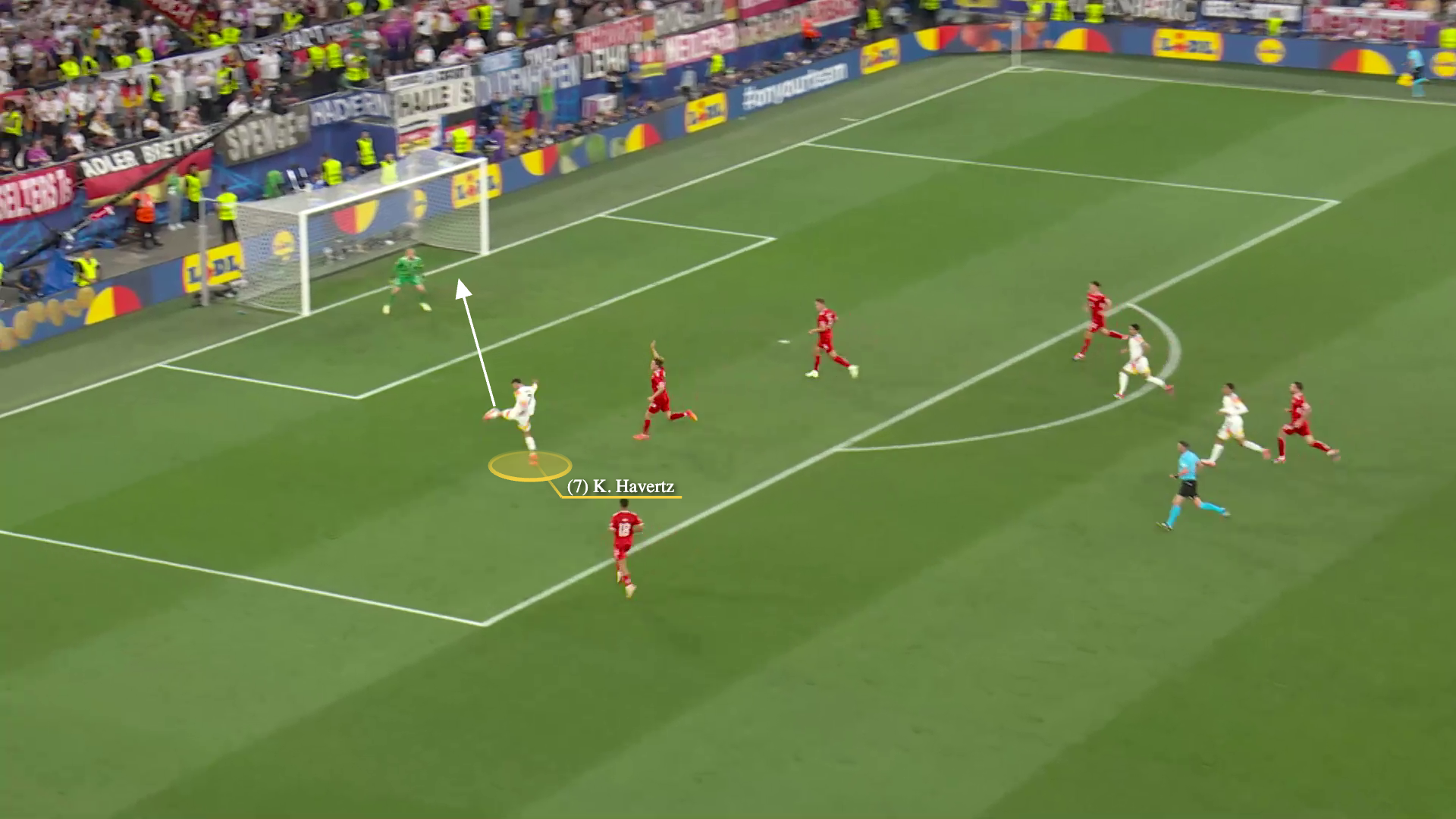
Although Rudiger’s long passes are a viable attacking option, Germany had to change their setup to ask Denmark different questions.
In the second half, they changed their structure from 3-1 to 4-2 with Kroos alongside Andrich and launched the attacks from deeper positions.
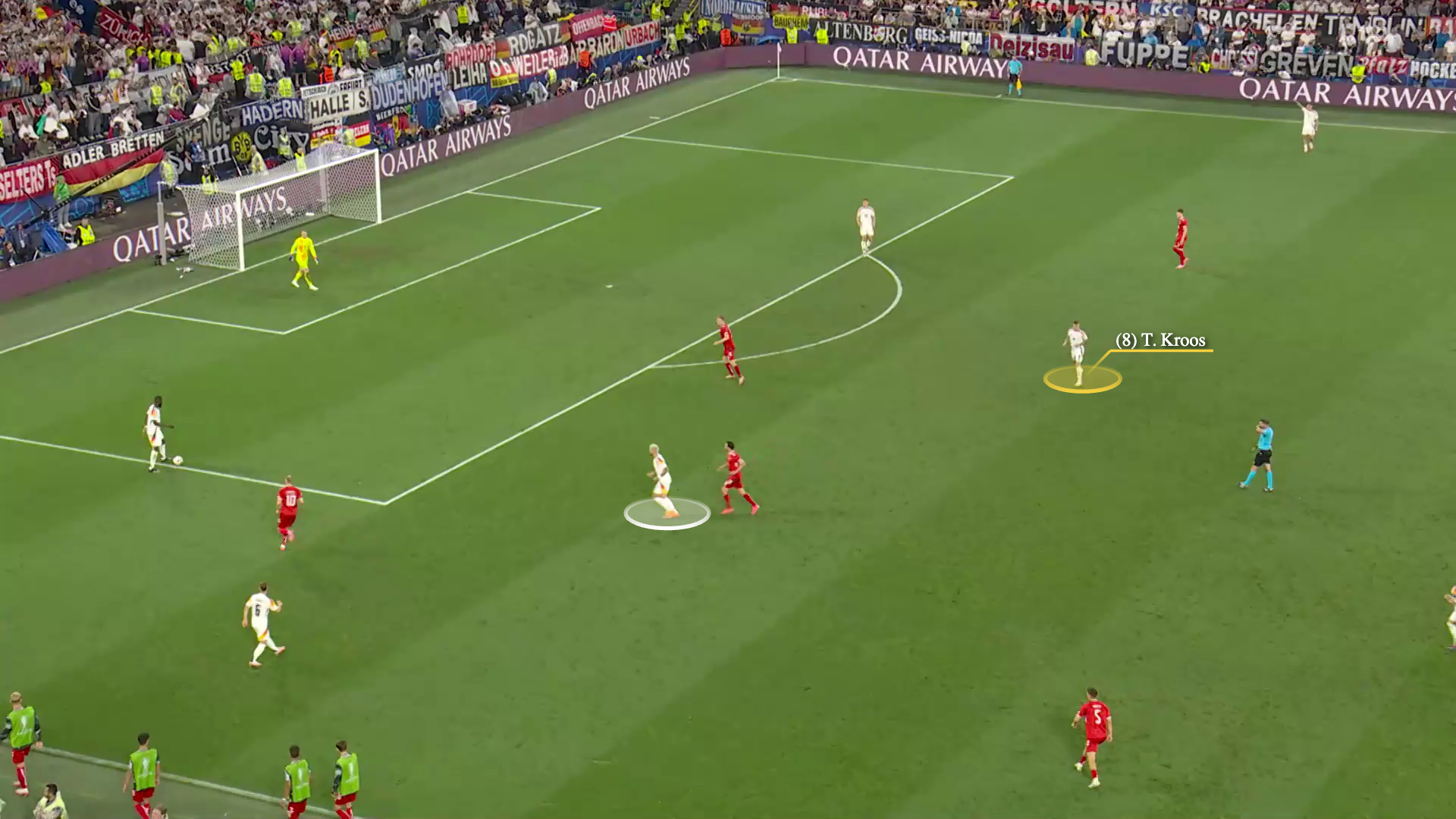
Denmark responded by pushing Hojbjerg to mark Kroos, but that increased the distance between their midfield and defensive line, leaving them vulnerable in that area and in case they pushed up, the German centre-backs could play long passes behind the defence.
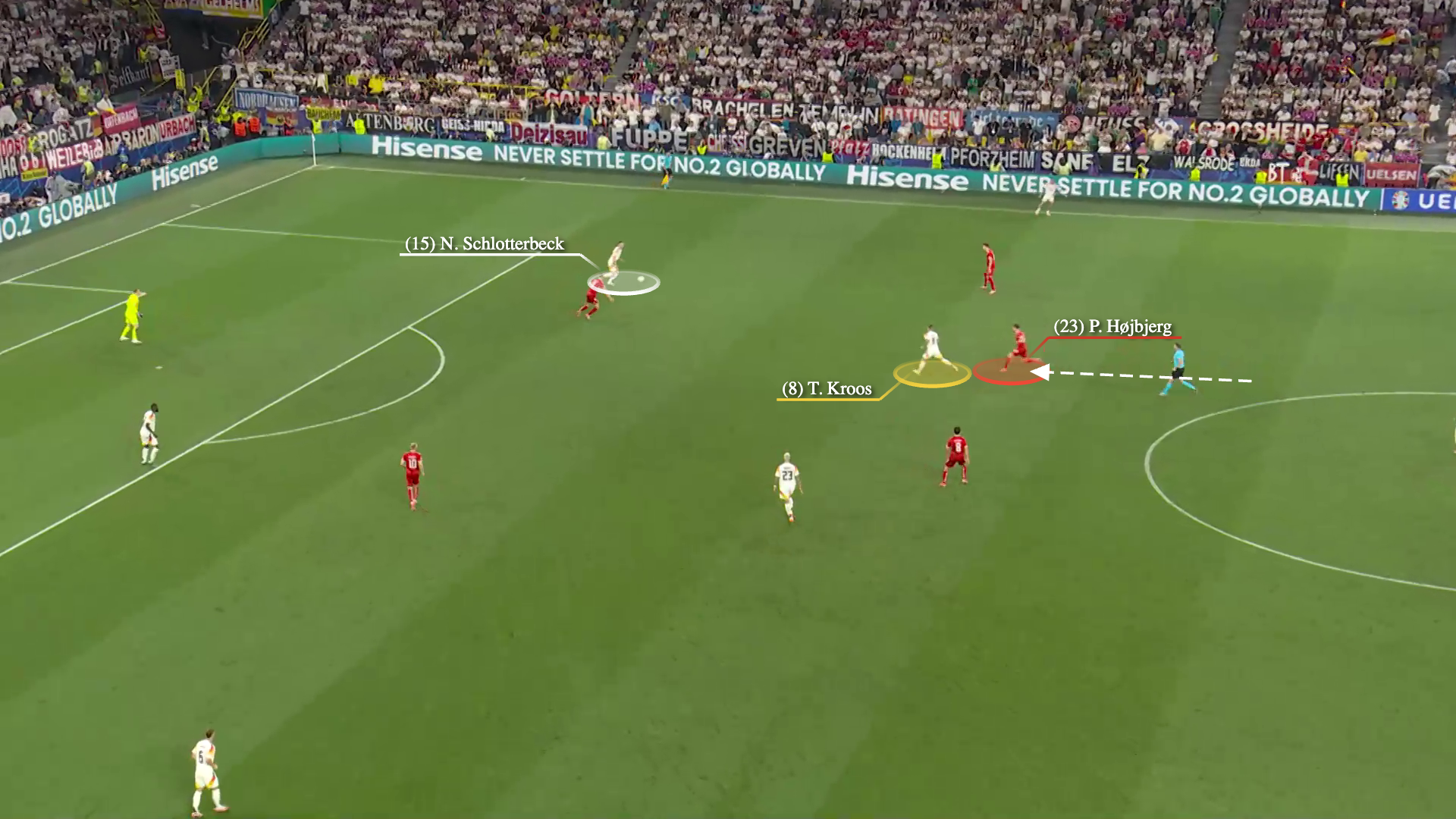
In this example, Havertz drops out to offer himself as a passing option, forcing the Danish defense to move up. Schlotterbeck spots Musiala’s complementary run behind the defense, which is fired in two directions, and passes the ball into his path, with Sane making a similar run on the other side.
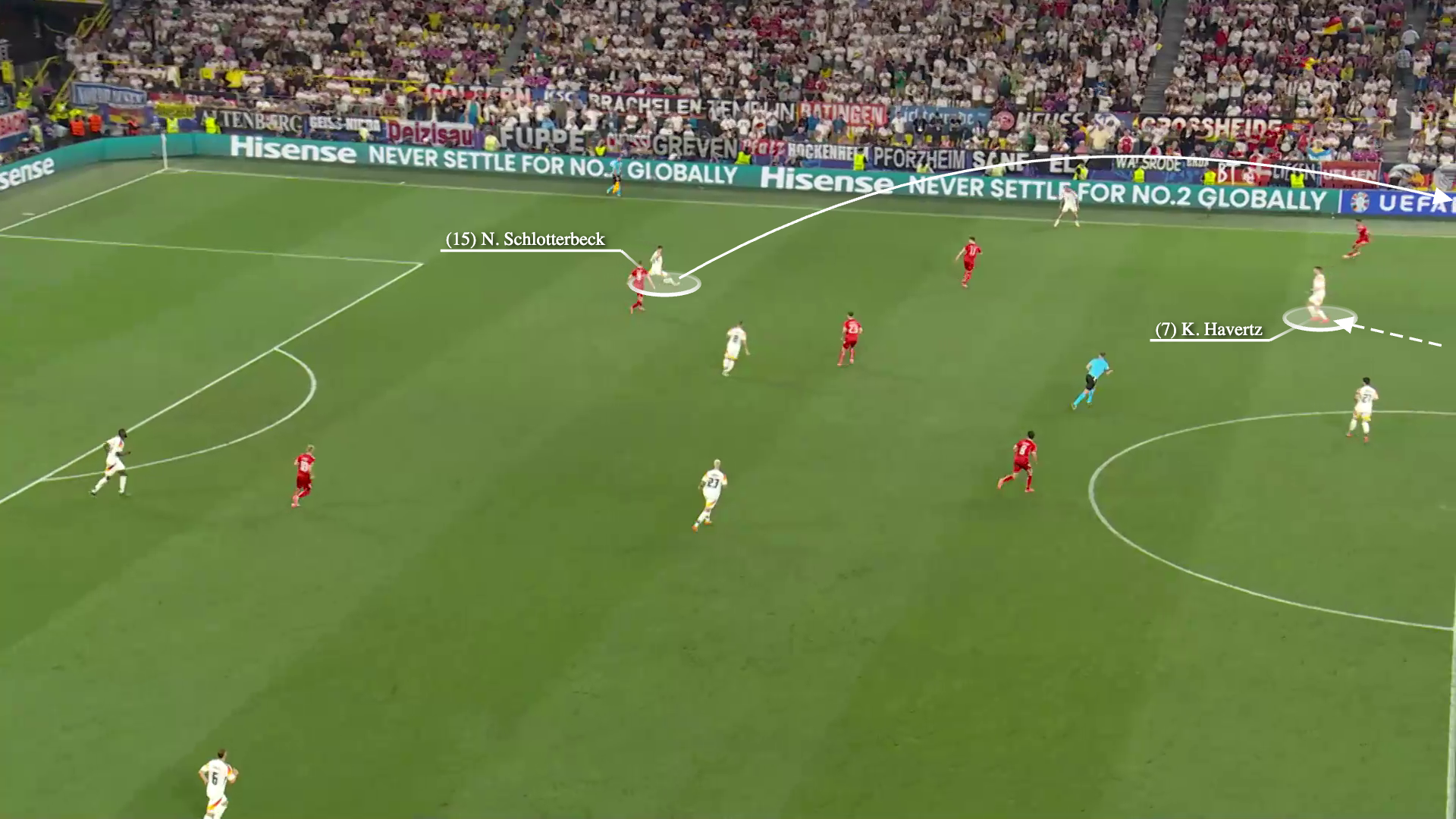
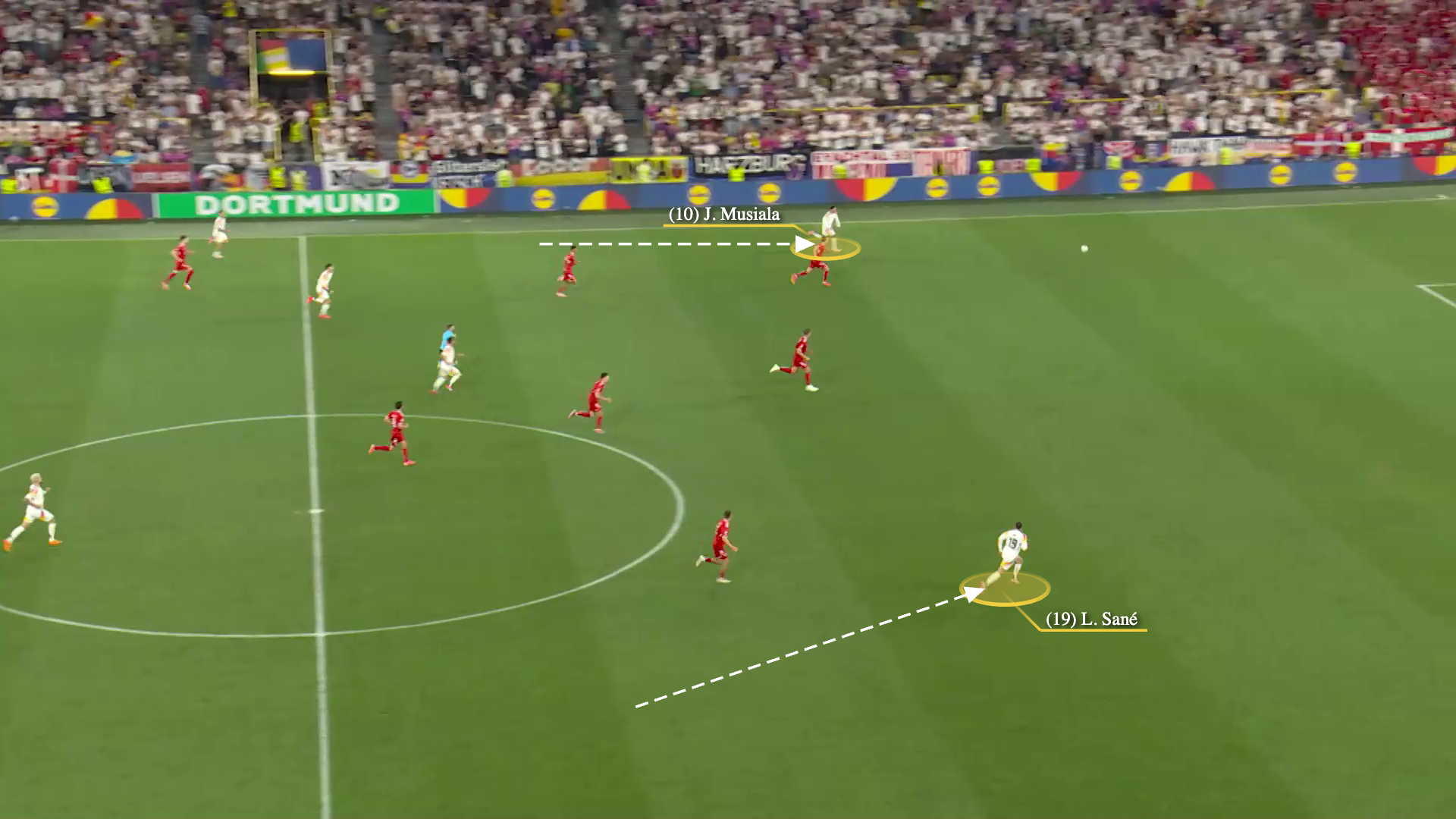
Musiala’s back pass was intercepted by Vestergaard but Germany managed to win a penalty after David Raum’s cross hit Andersen’s right hand. Havertz scored from the spot to give the Germans the lead.
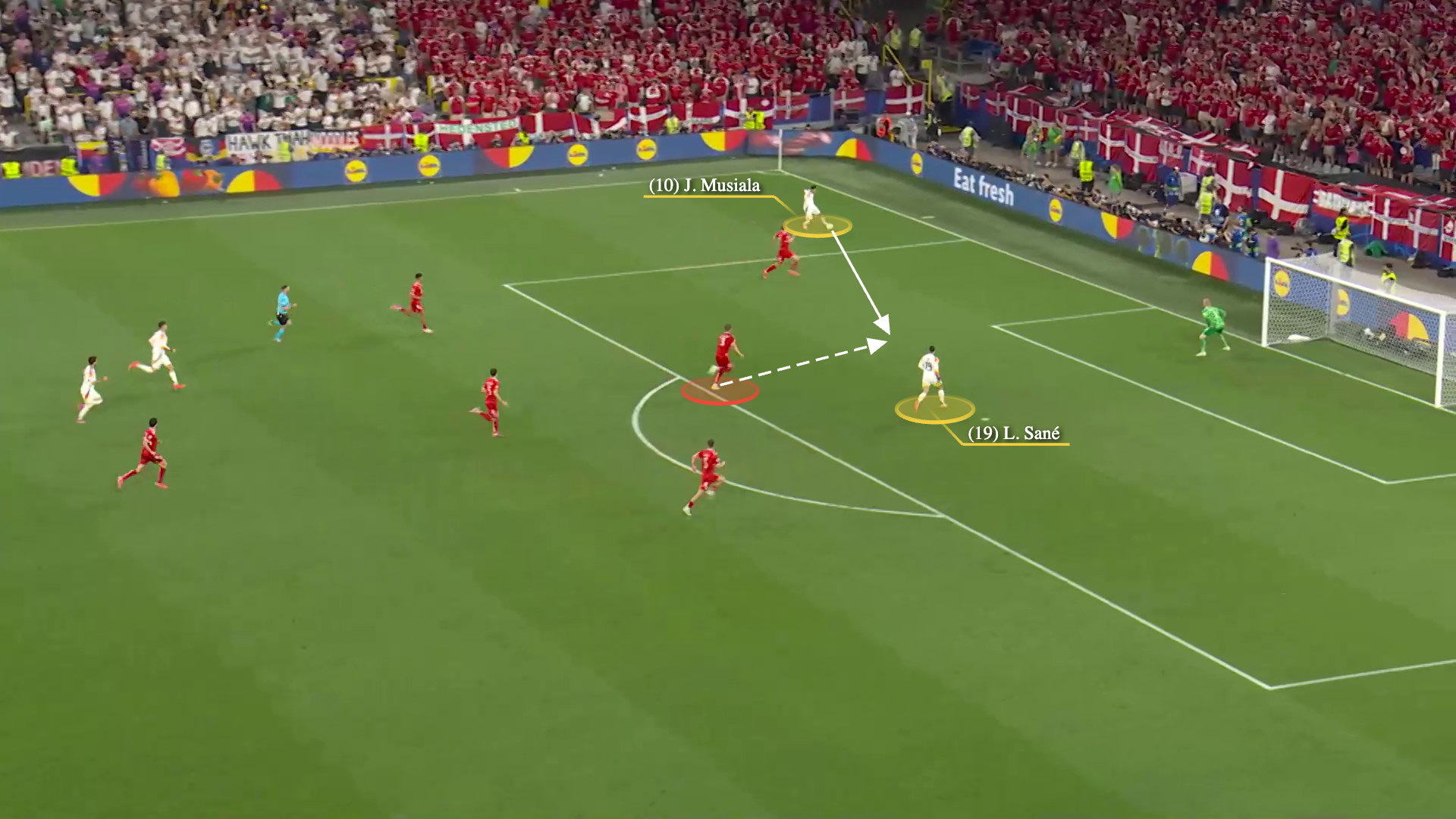
Germany’s second goal came from an identical situation. Here, Hojbjerg and Delaney push towards Kroos and Emre Can and Musiala fall into the space between the lines, forcing Andersen to follow.
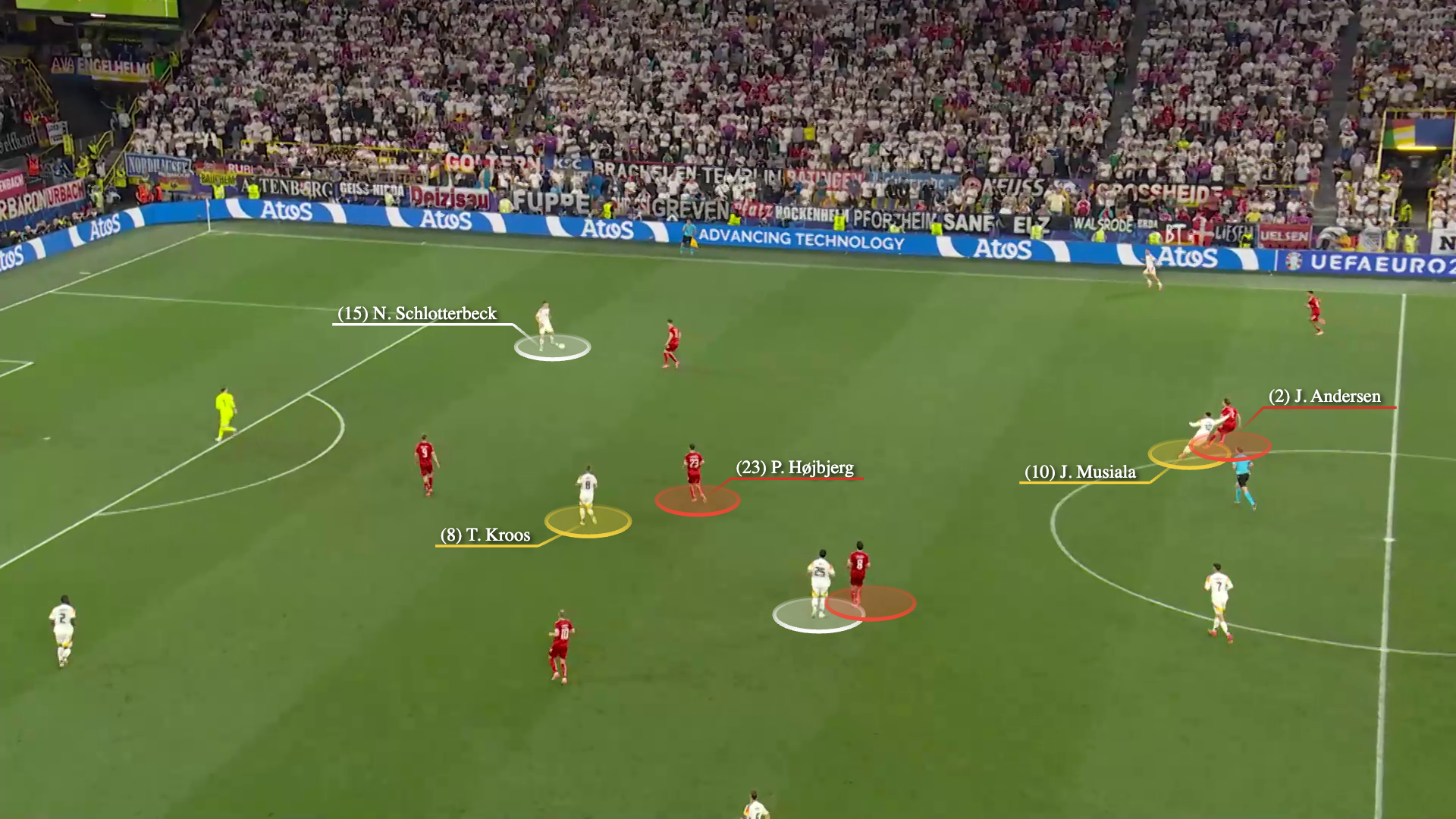
Musiala then changes direction and makes a run behind the defense, where Schlotterbeck plays the long pass…
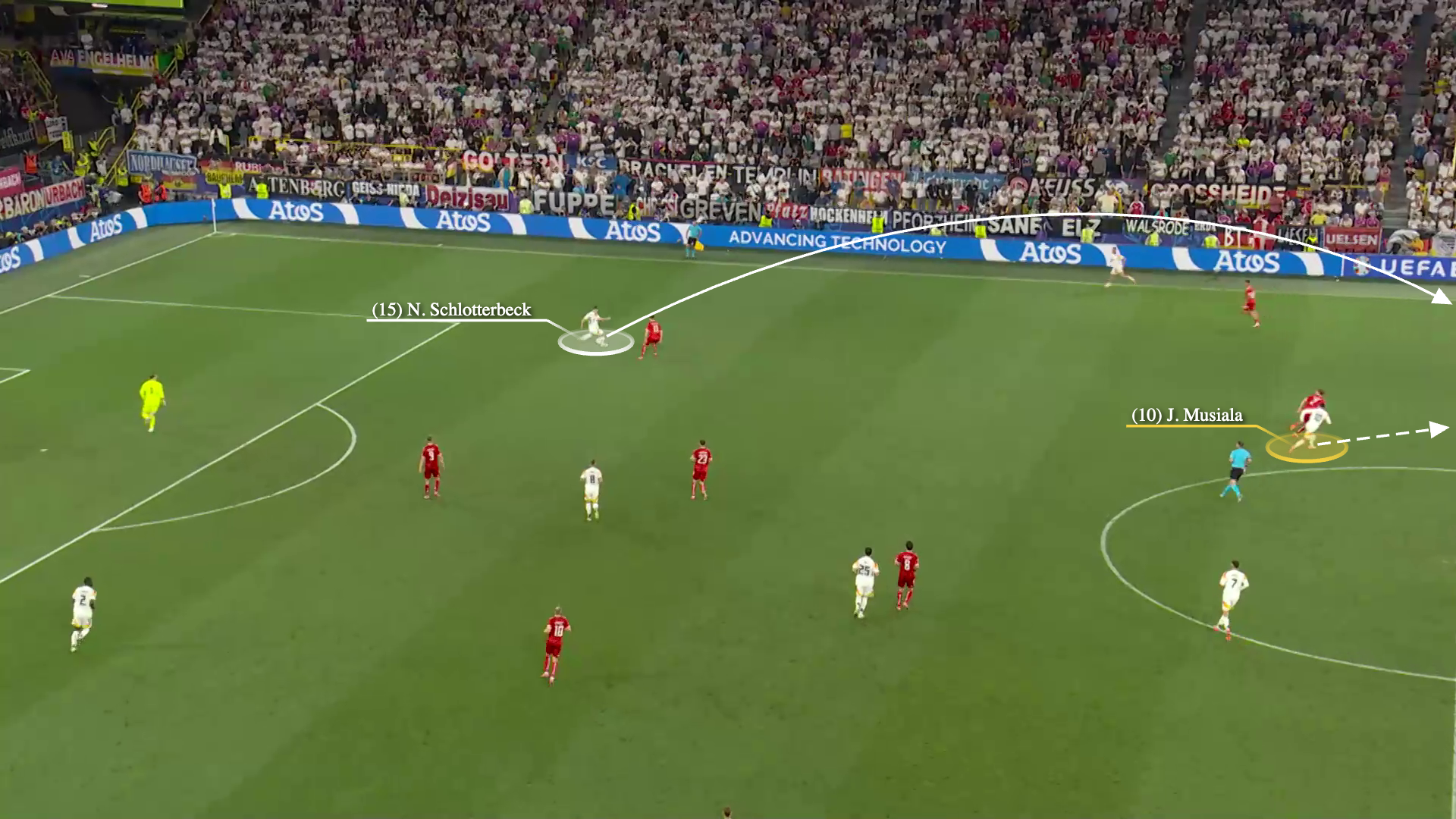
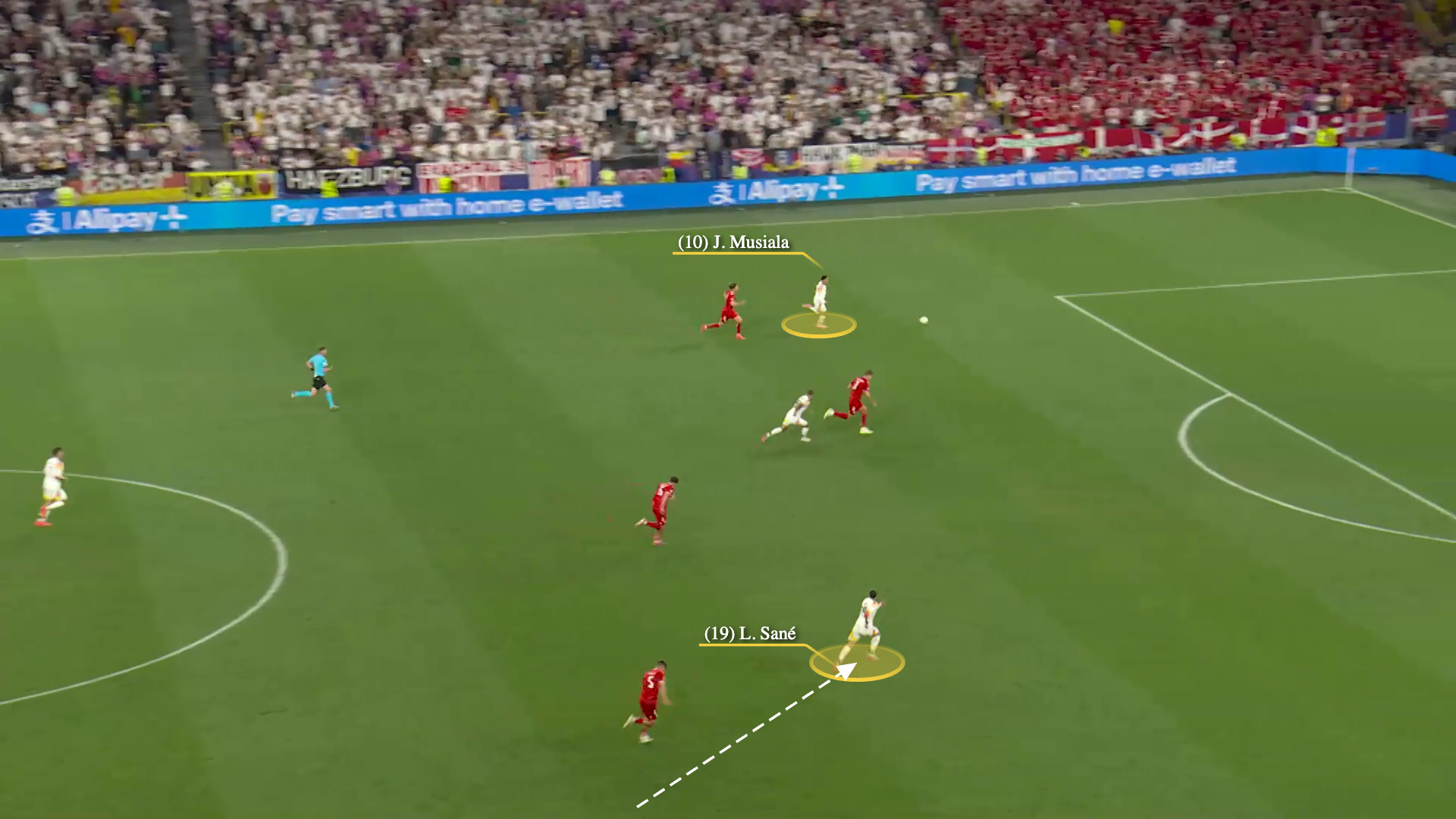
…and the Bayern Munich striker slots the ball into the bottom corner to make it 2-0.
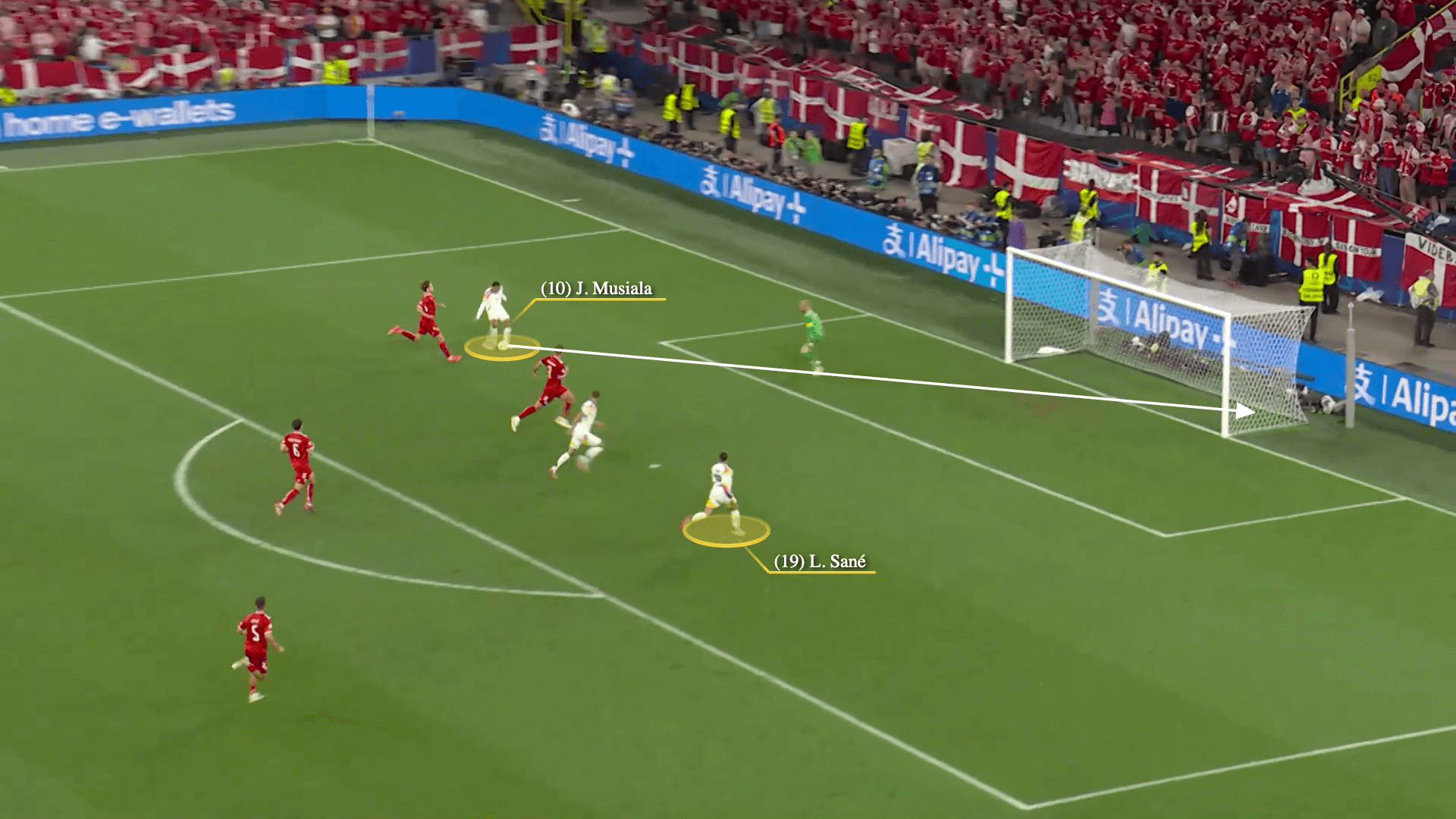
In the second part of the first half, Germany suffered with and without the ball, but adjusting their build-up structure at half-time and switching to a clearer five-man defense without ball possession with the Can’s introduction, she put herself on track for the quarterfinals.
Germany’s individual quality and consistent style make them a serious title contender. His ability to fine-tune his approach only adds to his strengths.